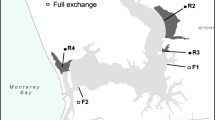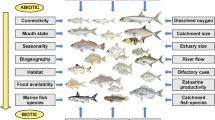Abstract
In coastal lagoons with occasional connection to oceans, variations in physicochemical conditions and biological responses can be pronounced. To examine the influence of variable rainfall and tidal flushing, we measured, over a 4-year period, salinity, temperature and dissolved oxygen, and fish abundances, in Devereux Slough, a coastal lagoon occasionally connected to the Pacific Ocean along the California coast. We test the hypotheses that salinity is the primary influence on fish composition, and that fish density is affected by freshwater discharge and by berm breaches. During our sampled years, annual rainfall varied from 188 to 971 mm, and the sand berm separating the Slough from the ocean breached in each year except 2007, a drought period. Average yearly salinity ranged from 7.7 to 37.1 ppt. Hypoxic conditions in the near-bottom water were common each year. The best predictor of the fish composition was salinity, and an indirect correlation with fresh water discharge was responsible for much of the temporal variation in the fish assemblage. The interaction between salinity, state of the estuary mouth (open vs. closed), and precipitation significantly predicted densities of Fundulus parvipinnis (Girard 1984).








Similar content being viewed by others
References
Allen, L. G. & M. H. Horn, 1975. Abundance, diversity and seasonality of fishes in Colorado Lagoon, Alamitos Bay, California. Estuarine and Coastal Marine Science 3: 371–380.
Barnes, R. S. K., 1980. Coastal Lagoons: The Natural History of a Neglected Habitat. Cambridge University Press, Cambridge, U.K.
Bennett, B. A., 1985. A mass mortality of fish associated with low salinity conditions in the Bot River estuary. Transactions in Royal Society South Arica 45: 437–448.
Beighley, R. E., J. M. Melack & T. Dunne, 2003. Impacts of California’s climatic regimes and coastal land use change on stream flow characteristics. Journal of the American Water Resources Association 29: 1419–1433.
Brooks, A. J., 1999. Factors influencing the structure of an estuarine fish community: the role of interspecific competition. Ph.D. Thesis. University of California, Santa Barbara.
Clarke, K. R. & R. M. Warwick, 1994. Change in Marine Communities: An Approach to Statistical Analysis and Interpretation. Natural Environment Research Council, Plymouth Marine Laboratory, Plymouth.
Collins, J. N., E. D. Stein, M. Sutula, R. Clark, A. E. Fetscher, L. Grenier, C. Grosso & A. Wiskind, 2008. California Rapid Assessment Method (CRAM) for Wetlands and Riparian Areas. www.cramwetlands.org.
Davis, F. W., D. Theobald, R. Harrington & A. Parikh, 1990. Campus Wetlands Management Plan, Part 2, Technical Report on Hydrology, Water Quality and Sedimentation of West and Storke Campus Wetlands. University of California, Santa Barbara.
Day, J. H., 1981. Summaries of current knowledge on 43 estuaries. Estuarine Ecology with Particular Reference to Southern Africa. A.A. Balkema, Cape Town: 259–341.
Everett, J. D., M. Baird, & I. Suthers, 2007. Nutrient and plankton dynamics in an intermittently closed/open lagoon, Smiths Lake, south-eastern Australia: an ecological model. Estuarine, Coastal and Shelf Science 72: 690–702.
Ferren, W. R., Jr., D. Capralis & D. Hickson, 1987. Campus wetlands management plan, Part I, Technical report on the botanical resources of West and Storke Campuses. Herbarium Report No. 12, University of California, Santa Barbara.
Gale, E., C. Pattiaratchi & R. Ranasinghe, 2006. Vertical mixing processes in intermittently closed and open lakes and lagoons, and the dissolved oxygen response. Estuarine, Coastal and Shelf Science 69: 205–216.
Gladstone, W., N. Hacking & V. Owen, 2006. Effects of artificial openings of intermittently opening estuaries on macroinvertebrate assemblages of the entrance barrier. Estuarine Coastal and Shelf Science 67: 708–720.
Gobler, C. J., L. A. Cullison, F. Koch, T. M. Harder & J. W. Krause, 2005. Influence of freshwater flow, ocean exchange, and seasonal cycles on phytoplankton – nutrient dynamics in a temporarily open estuary. Estuarine, Coastal and Shelf Science 65: 275–288.
Goodman, D., 2008. Effective estuarine management: a case study of a California estuary and its ecological and political characteristics. Ph.D. Thesis. University of California, Santa Barbara. 358 pp.
Griffiths, S. P., 2001. Factors influencing fish composition in an Australian intermittently open estuary: is stability salinity-dependent? Estuarine, Coastal and Shelf Science 52: 739–751.
Heck, K. L., K. W. Able, M. P. Fahay & C. T. Romanet, 1989. Fishes and decapod crustaceans of Cape Cod eelgrass meadows: species composition, seasonal abundance patterns and comparison with unvegetated substrates. Estuaries 12: 59–65.
Heltshe, J. F., 1983. Estimating species richness using the jackknife procedure. Biometrics 39: 1–11.
Hoise, G. W. & T. G. Cochran, 1994. Mesoscale distribution patterns of macrozooplankton communities in Prydz bay, Antartica- January to February 1991. Marine Ecology Progress Series 106: 21–39.
James, N. C., P. D. Cowley, A. K. Whitfield & S. Lamberth, 2007. Fish communities in temporarily open/closed estuaries from the warm- and cool-temperate regions of South Africa – a review. Reviews in Fish Biology & Fisheries 17: 565–580.
Jones, M. V. & R. J. West, 2005. Spatial and temporal variability of seagrass fishes in intermittently closed and open coastal lakes in southeastern Australia. Estuarine, Coastal and Shelf Science 64: 277–288.
Kuris, A. M., R. F. Hechinger, J. C. Shaw1, K. L. Whitney, L. Aguirre-Macedo, C. A. Boch, A. P. Dobson, E. J. Dunham4, B. L. Fredensborg, T. C. Huspeni6, J. Lorda, L. Mababa, F. T. Mancini, A. B. Mora, M. Pickering, N. L. Talhouk, M. E. Torchin & K. D. Lafferty, 2008. Ecosystem energetic implications of parasite and free-living biomass in three estuaries. Nature 454: 515–518.
Kjerfve, B. (ed.), 1994. Coastal Lagoon Processes. Elsevier Oceanographic Series 60. Elsevier, Amsterdam. 577 pp.
Lafferty, K. D., 2008. Camp Pendleton Tidewater Goby monitoring project report (2008 update). U.S. Geological Survey Open File Report.
Lafferty, K. D., C. C. Swift & R. F. Ambrose, 1999. Extirpation and recolonization in a metapopulation of an endangered fish, the tidewater goby. Conservation Biology 13: 1447–1453.
Largier, J. L., S. V. Smith & J. T. Hollibaugh, 1997. Seasonally hypersaline estuaries in Mediterranean-climate regions. Estuarine Coastal and Shelf Science 45: 789–797.
Magurran, A. E., 2006. Measuring Biological Diversity. Blackwell Science, Malden, MA.
McGinnis, S. M. & D. Alcorn, 2006. Field Guide to Freshwater Fishes of California. University of California Press.
Middaugh, D. P., 1988. Salinity tolerance of young topsmelt, Atherinops affinis, cultured in the laboratory. California Fish and Game 74: 232–235.
Palmer, T. A., P. A. Montagna, J. B. Pollack, R. D. Kalke & H. R. De Yoe, 2011. The role of freshwater inflow in lagoons, rivers, and bays. Hydrobiologia 667: 49–67.
Peterson, G. W. & R. E. Turner, 1994. The value of salt marsh edge vs. interior as habitat for fish and decapod crustaceans in a Louisiana tidal marsh. Estuaries 17: 235–262.
Pollard, D. A., 1994. A comparison of fish assemblages and fisheries in intermittently open and permanently open coastal lagoons on the south coast of New South Wales, south-eastern Australia. Estuaries 17: 631–646.
Rountree, R. A. & K. W. Able, 1992. Fauna of polyhaline subtidal marsh creeks in southern New Jersey: composition, abundance and biomass. Estuaries 15: 171–185.
Sklar, F. & J. Browder, 1998. Coastal environmental impacts brought about by alterations to freshwater flow in the Gulf of Mexico. Environmental Management 22: 547–562.
Skinner, T., J. B. Adams & P. T. Gamaa, 2006. The effect of mouth opening on the biomass and community structure of microphytobenthos in a small oligotrophic estuary. Estuarine, Coastal and Shelf Science 70: 161–168.
Smith, K. J. & K. W. Able, 1994. Salt-marsh tide pools as winter refuges for the mummichog, Fundulus heteroclitus, in New Jersey. Estuaries 17: 226–234.
Snow, G. C. & J. B. Adams, 2007. Relating microalgal spatial patterns to flow, mouth and nutrient status in the temporarily open/closed Mngazi estuary, SouthAfrica. Marine and Freshwater Research 58: 1032–1043.
Swift, C. C., J. L. Nelson, C. Maslow & T. Stein, 1989. Biology and distribution of the tidewater goby, Eucyclogobius newberryi (Pisces: Gobiidae) of California. Natural History Museum of Los Angeles, Scientific Contribution 404: 1–19.
Teske, P. R. & T. H. Wooldridge, 2002. What limits the distribution of subtidal macrobenthos in permanently open and temporarily open/closed South African estuaries: salinity vs. sediment particle size. Estuarine, Coastal and Shelf Science 57: 225–238.
USACE, 2002. HEC-RAS river analysis system, user’s manual, US Army Corps of Engineers, Hydrologic Engineering Center, Davis.
United States Fish and Wildlife Service, 2006. Draft Recovery Plan for the Endangered (Eucyclogobius newberryi). Ventura, CA.
Whitfield, A. K., 1994. Fish species-diversity in southern African estuarine systems-An evolutionary perspective. Environmental Biology of Fish 40: 37–48.
Whitfield, A. K., 1999. Ichthyofaunal assemblages in estuaries: a South African case study. Reviews in Fish Biology and Fisheries 9: 151–186.
Whitfield, A. K., A. W. Paterson, A. H. Bok & H. M. Kok, 1994. A comparison of the ichthyofaunas in two permanently open eastern Cape estuaries. South African Journal of Zoology 29:175-1855-185.
Young, G. C. & I. C. Potter, 2002. Influence of exceptionally high salinities, marked variations in freshwater discharge and opening of estuary mouth on the characteristics of the ichthyofauna of a mormally-closed estuary. Estuarine, Coastal and Shelf Science 55: 223–246.
Young, G. C., I. C. Potter, G. A. Hyndes & S. De Lestang, 1997. The ichthyofauna of an intermittently open estuary: implications of bar breaching and low salinities on faunal composition. Estuarine, Coastal and Shelf Science 45: 53–68.
Acknowledgements
This research was supported by the NSF-funded Santa Barbara Coastal Long-term Ecological Research Program (Awards OCE-9982105 and OCE-0620276), the Coastal Fund, the UC Natural Reserve System and volunteer service. We thank Kevin Lafferty and Cristina Sandoval of Coal Oil Point Reserve for logistical support and advice, Tara Longwell, Darryl Yin, Michael Massoud, Alex Hurst and Kevin Le for field assistance, and Blair Goodridge and Scott Coombs with hydrological data.
Author information
Authors and Affiliations
Corresponding author
Additional information
Handling editor: Pierluigi Viaroli
Rights and permissions
About this article
Cite this article
Collins, D.G., Melack, J.M. Biological and chemical responses in a temporarily open/closed estuary to variable freshwater inputs. Hydrobiologia 734, 97–113 (2014). https://doi.org/10.1007/s10750-014-1872-y
Received:
Revised:
Accepted:
Published:
Issue Date:
DOI: https://doi.org/10.1007/s10750-014-1872-y




